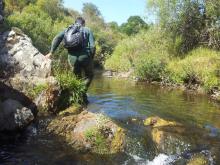In order to increase awareness of the Iberian desman, its distribution and the hábitat it lives in, the LIFE+ Desmania Project envisages the following actions:

- To undertake a census to determine the current distribution, analyse occupied or potential habitats, and understand the biology, ecology and ethology (or behaviour) of the species in the broadest terms. This will help to determine specific conservation activities. There will also be droppings collections, genetic analysis, radio telemetry, thermal draughts study, identification of benthic macroinvertebrates, freshwater science analysis, pesticide analysis of habitats, analysis of biological take up of heavy metals in macroinvertebrates and aquatic fauna.
- Actions to improve continuity along and across rivers: elimination of water wheels, and unauthorized crossing dams, suppression of water removal from rivers, slick removal, extraction of sand and cement from channels, innovative activities using non-evasive techniques in the environment, and the use of long range equipment.
- Actions to improve and conserve the characteristic habitats of the Iberian desman: restoration of the vegetation cover by repopulation, improved planting, elimination of unnatural cork from rivers and riverside woodland to facilitate regeneration and adaptation of the river’s luminosity in order to obtain diversity of macroinvertebrates. Restoration of areas affected by natural catastrophes such as forest fires or indirect damage caused by infrastructures with unprotected erosive hazards.
- Reduction and control of threats from other species: traps for the American mink, a non-local introduced species. Collection of samples of the predator for later analysis in order to identify its degree of spread. Use of light traps and retention systems in compliance with protocols, safety measures, and the setting up of permanent sections.
- Reduce or eliminate diseases that are not natural to the desman or the habitats in which it lives: systems for passive treatment of leached chemicals; construction of pools for biological capture of heavy metals; avoidance of water removal from rivers, with volumes that maintain the ecological balance in the system adjacent to the habitats; construction of mini water measurement devices, adapted to the channel and measurement of removed water volume; adjustment of existing water measurers by incorporating sluice limiters; lightweight, portable water measurers in mountainous areas.
- Decrease pesticide threats from high priority habitats where the Iberian desman lives. Implementation diagram for best practice for reducing the effects of diseases such as Phytophthora alni, adjusting vegetation structures on riversides with suitable tools, disinfection of tools, examples of material contaminated by the disease, demonstration of low cost treatment. Forestry work, the aim of which is to maintain and improve the structure of the habitat. Sustainable management model for habitats so that traditional models for activity are maintained: local awareness raising, involvement of fishing community, adventure sports groups, and people living in affected areas; good practice when using traditional measures such as the advantages of firewood and wood for domestic use, the implementation of usage and management criteria; undertaking of activities in rivers and habitats where the species is present in adequate numbers in order to respect this situation. The idea is to create a channel for participation for these social sectors and competent administrations in the management model and so unite criteria and aims for habitat management.
